| Srl | Item |
| 1 |
ID:
130549
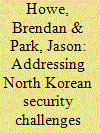

|
|
|
|
|
| Publication |
2014.
|
| Summary/Abstract |
Purpose-Discuss the potential of non-state centric economic cooperation.
Design/methodology/approach-Traditional engagement policies vis-à-vis North Korea have been state-centric, reciprocity-driven and ultimately, unsuccessful. This article proposes the promotion of sustainable, good-faith and meaningful economic exchanges by enrolling the active participation of North Korean elites through alignment with their vested interests.
Findings-Although controversial and even abhorrent from a normative perspective, the approach is eminently pragmatic and necessary to address the limited policy alternatives of an increasingly insecure regime which may eventually be forced to pursue drastic means to ensure its survival.
Practical implications-Non-state-centric international economic engagement is a non-exclusive policy prescription that seeks to broaden the range of viable policy options available to the North Korean regime.
|
|
|
|
|
|
|
|
|
|
|
|
|
|
|
|
| 2 |
ID:
109739
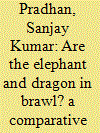

|
|
|
| 3 |
ID:
130610
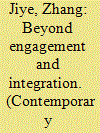

|
|
|
|
|
| Publication |
2014.
|
| Summary/Abstract |
As part of its new strategy of "retuming to the Asia-Pacific region", the A Obama administration has adopted some tough economic policies towards China, notably promoting the Trans-Paci?c Partnership (TPP) and attempting to establish new rules of international trade and investment aimed at strengthening economic ties with other Western countries through the Trans-Atlantic Trade and Investment Partnership Agreement(TTlP ), both of which tend to compress the geopolitical space for China's economic rise. The administration is also using a 'green barrier' to suppress the development of China's high-tech industry, and using economic diplomacy and investment restrictions against Chinese state-owned enterprises. This paper seeks to examine and analyze the causes of shifts in the U .S. economic strategy towards China.
|
|
|
|
|
|
|
|
|
|
|
|
|
|
|
|
| 4 |
ID:
130601
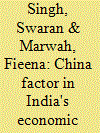

|
|
|
|
|
| Publication |
2014.
|
| Summary/Abstract |
The technology driven time-and-space shrink in recent decade have turned open oceans from barriers to bridges. This has opener new frontiers for trade and transportation, for resource exploitation as also for adventurous scientific explorations into the history 0 human evolution as also into our future. This recent paradigm shift is distinct from the discovery of steam ship leading to naval fleets ancient colonialism in the 19"'century which was focused not only on European powers' control and exploits but also on continental humarjand material resources of their colonies across the world. The recent maritime discourses have instead opened up enormous new avenue entities even to achieve their basic national development and security objectives.
|
|
|
|
|
|
|
|
|
|
|
|
|
|
|
|
| 5 |
ID:
164071
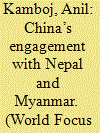

|
|
|
|
|
| Summary/Abstract |
With the rise of China and its growing economic presence in South Asia, the power structure of the region is changing. India’s traditional primacy in the region is challenged by a growing Chinese presence. Both Nepal and Myanmar are very important neighbours for India. Nepal, most strategically located and Myanmar, through which India’s most prestigious project “Act East” passes. Nepal takes pride in its history of never having been colonised and has an important geostrategic position, with India and China on either side. However, contrary to conventional notions of a harmonious diplomatic relationship, there is a sharp difference in the way Nepal and India view each other.
|
|
|
|
|
|
|
|
|
|
|
|
|
|
|
|
| 6 |
ID:
109813
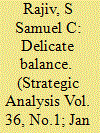

|
|
|
|
|
| Publication |
2012.
|
| Summary/Abstract |
India's foreign policy interactions with Israel are marked by a political discreetness which is in contrast to its prominent political engagement with the Palestinians and countries of the Arab world. India plays down its robust defence engagement with Israel, censures Israeli policies regarding the Palestinians, supports Palestinian-related resolutions at multi-lateral forums like the UN, differs strongly from Israeli policy on issues such as Iran's nuclear programme while being opposed to the possibility of Iran acquiring nuclear weapons capability. This policy has expanded the space for India to pursue its foreign policy and national interest goals, as attested to by the robust political and economic interaction with the Palestinians and the Arab countries, and rising defence and economic engagement with Israel despite certain domestic constituencies opposed to such a partnership. However, the limitations of such a policy include the minimal role that India has been able to play in the Middle East peace process, 'diplomatic heartburn' of an ally deeply involved in the security sphere-as is evident in the Israeli reaction to the Indian stance on the Goldstone report, for instance-and limited 'comfort zones' if crisis situations arise. Greater political engagement could be a bulwark against such tendencies and also provide important opportunities to convey India's concerns regarding the Palestinians more forcefully.
|
|
|
|
|
|
|
|
|
|
|
|
|
|
|
|
| 7 |
ID:
117787


|
|
|
| 8 |
ID:
164672
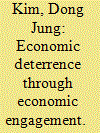

|
|
|
|
|
| Summary/Abstract |
This essay suggests that a state’s economic engagement with a potential military aggressor can be understood as an attempt to increase its deterrent capability. It first introduces the concept of economic deterrence and derives three strategies of economic deterrence from classic deterrence theory: (1) punishment, (2) denial, and (3) diminution. Next, it suggests that economic engagement can be employed to advance the ability, credibility, and communication for economic deterrence, as well as to create favorable conditions to adopt the three economic deterrence strategies. Finally, the essay discusses the requirements for effective employment of engagement policy for economic deterrence.
|
|
|
|
|
|
|
|
|
|
|
|
|
|
|
|
| 9 |
ID:
152586
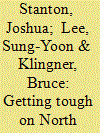

|
|
|
|
|
| Summary/Abstract |
For the past quarter century, the United States and South Korea have tried to convince North Korea to abandon its nuclear aspirations. Beginning in the early 1990s, Washington attempted to bargain with Pyongyang, while Seoul pursued a strategy of economic engagement, effectively subsidizing Pyongyang with aid and investment even as it continued to develop nuclear weapons. Then, after North Korea tested an atomic bomb in 2006, the United States pressed the UN Security Council to impose sanctions on North Korea. Yet at the urging of South Korea and for fear of angering China, the United States failed to use its full diplomatic and financial power to enforce those sanctions. All along, the goal has been to induce North Korea to open up to the outside world and roll back its nuclear and missile programs.
|
|
|
|
|
|
|
|
|
|
|
|
|
|
|
|
| 10 |
ID:
179482
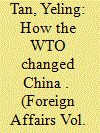

|
|
|
|
|
| Summary/Abstract |
When China joined the World Trade Organization in 2001, the event was hailed as a pivotal development for the global economic system and a bold marker ofthe country’s commitment to reform. It took 15 long years ofnegotiation to reach the deal, a re4ection of the challenge of reconciling China’s communist command economy with global trading rules and ofthe international community’s insistence that China sign on to ambitious
commitments and conditions.
|
|
|
|
|
|
|
|
|
|
|
|
|
|
|
|
| 11 |
ID:
109744
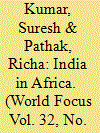

|
|
|
| 12 |
ID:
130600
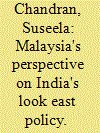

|
|
|
|
|
| Publication |
2014.
|
| Summary/Abstract |
The year 2012 completed 20 years of India's Look East Policy (LEP). Launched by former Indian Prime Minister P.V. NarashimeRao in 1992, this policy had its genesis in the end of the cold war following the collapse of the Soviet Union. To India, this policy was more than just a foreign policy alternative as it provided a development alternative as well, in synchronization with the globalization paradigm and the resurgence of Asia as an economic powerhouse. The 1990: saw a period rapid economic development and growth of Asian countries - especially Southeast Asia. With the abrupt collapse c the Soviet Union in 1991, India was left 'deprived' (the Soviet Union was lndia's strongest partner), and started to seek new markets t~
fuel its own economic growth. Thus Indian Prime Minister at the time P.V. Narasimha Rao, came up with the concept of a "Look East Policy for India. This was a policy of economic engagement with Southeast Asia and East Asia, to achieve two objectives. First was to encourage trade links with individual partners, and second, to provide foreign employment for India's own expanding work force (R.P. Khanna, 1991,6-7).
|
|
|
|
|
|
|
|
|
|
|
|
|
|
|
|
| 13 |
ID:
137198
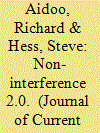

|
|
|
|
|
| Summary/Abstract |
China’s non-interference policy has come under scrutiny in regards to its growing and deepening relations in Africa. The policy has come to represent an about-face from conditional assistance and investment associated with the Washington Consensus. Although often well received in much of the global South, this policy has drawn a lot of criticism from the West and others. These commentators have perceived non-interference as an opportunistic and often inconsistent instrument for enabling China’s increasing access to African resources and markets. This article suggests that despite some consistent support for the rhetoric of non-interference, China’s implementation of the policy has become increasingly varied and context-ualized in reaction to Africa’s ever-more diversified political and economic landscape since the early 2000s.
|
|
|
|
|
|
|
|
|
|
|
|
|
|
|
|
| 14 |
ID:
144010
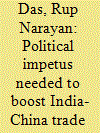

|
|
|
|
|
| Summary/Abstract |
In the narrative of the dynamic and yet complex Sino-Indian relations, bilateral economic relations between the two countries occupy a very critical space. With a combined population of 2.5 billion, China and India are the two most populous countries in the world constituting about 38% of world population. Together they account for one- tenth of gross domestic product of the world.
|
|
|
|
|
|
|
|
|
|
|
|
|
|
|
|
| 15 |
ID:
129871


|
|
|
| 16 |
ID:
114778


|
|
|
|
|
| Publication |
2012.
|
| Summary/Abstract |
This case study of Chinese migration to and economic engagement in Laos examines transnational networks and the agendas of particular and diverse actors within the context of post-Cold War globalization and statehood. In her study on the activities of economically motivated new Chinese migration to Laos, a country largely neglected by mainstream overseas Chinese studies, the author sets out to challenge the notion of the retreat and weakening of the state. Applying a migration studies perspective, she argues that transnational networks are not undermining state power but rather strongly impacting on the ways states are operating.
|
|
|
|
|
|
|
|
|
|
|
|
|
|
|
|
| 17 |
ID:
118555


|
|
|
| 18 |
ID:
082887


|
|
|
|
|
| Publication |
2008.
|
| Summary/Abstract |
The prosperity of the United States and China depends on helping China further integrate into the global economic system.
|
|
|
|
|
|
|
|
|
|
|
|
|
|
|
|
| 19 |
ID:
156605
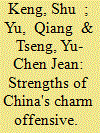

|
|
|
|
|
| Summary/Abstract |
China's trade with Taiwan has a political motive: winning the hearts and minds of the Taiwanese people. The effectiveness of China's economic statecraft can be examined in the Syuejia (Xuejia) case, where Taiwan put up strong resistance to the generous benefits offered by China. This article investigates the political implications of the Chinese-designed contract farming programme in Syuejia and argues that if economic favours are delivered, and positive impressions also created, political attitudes can be revised. Without these two prerequisites, however, replicating the Syuejia results elsewhere and thus disturbing the cross-Strait status quo will be difficult. When put in a theoretical context, the changes in the political landscape of Syuejia illustrate the interplay of economic interests and political identity.
|
|
|
|
|
|
|
|
|
|
|
|
|
|
|
|
| 20 |
ID:
133565


|
|
|
|
|
| Publication |
2014.
|
| Summary/Abstract |
The ascendancy of China has threatened the current hegemonic position of the United States. The US has responded by engaging deeper with countries in the region of Asia-Paci?c, strategically and economically. The Trans-Pacific Partnership is a part of the US. economic engagement in the region. Based on the realist theory of state action by Mastanduno et al, this paper argues that the Trans Paci?c Partnership is a natural strategy of the US. due to its international and domestic power position. TPP will bene?t the US. as a future trading template in Asia-Pacific.
|
|
|
|
|
|
|
|
|
|
|
|
|
|
|
|